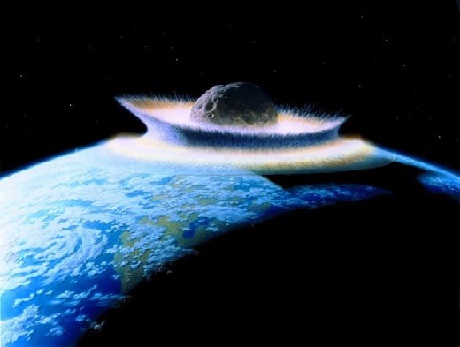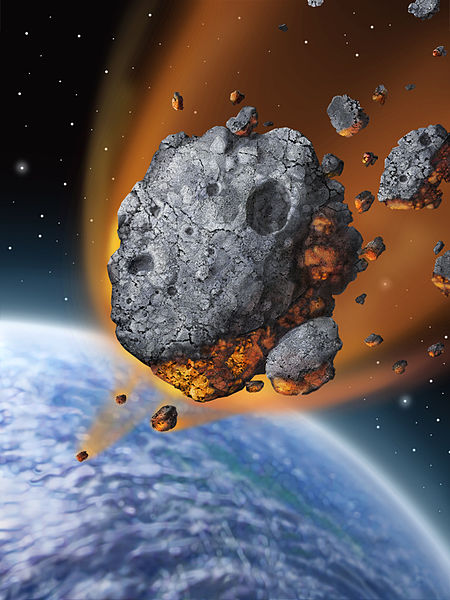The threat of an Earth-asteroid collision is very real. Historically, asteroids and comets have proven to be sources of incredible destruction, and they are thought to have caused at least one mass extinction. This has motivated geologists, scientists and engineers to start devising plans to deflect potentially lethal asteroids and protect the earth from the resulting devastating impact.
Introduction
Space is not empty. Out there, above our heads, countless celestial bodies trace their silent trajectories across the universe. Most of these paths diverge from that of the Earth’s by unimaginable distances. However, a select few are on course to end their journey by colliding with our relatively larger planet with enough force to cause mass extinction. Until very recently, living things on Earth could only count on the sheer probability of avoiding these potentially dangerous impacts. But now, with the dawn of the space age, scientists are now looking towards the skies and planning on ways to take chance out of the equation by deflecting collision course asteroids using engineering.
Near Earth Object Program
In 1998, the Near Earth Object Program was launched with the goal of cataloging 90% all near-Earth objects (NEO) that measure over 1 km in diameter [1]. As of now, the program has tracked a cumulative total of 10,555 near-Earth objects travelling through our solar system [2]. Each of these bodies is assigned a rating on the Torino scale, which measures the likelihood of collision with Earth. The Torino scale is simply an 11 point scale, where 0 means virtual certainty of no collision, and 10 means virtual certainty of a destructive impact [3].
But why catalog these near earth objects? The answer to that question is that human survival depends on it. As dramatic as that may sound, the threat and dire consequences of an asteroid collision are very real. Massive objects colliding at very high velocities produce destructive results (Fig. 1).
Impacts throughout history
On the morning of June 30, 1908, a tremendous explosion rocked the remote Siberian tundra, leaving 800 square miles and 80 million trees levelled in a radial pattern [4, Fig. 1]. Known as the Tunguska event, this destruction was far beyond the level of any weaponry that had even be dreamed up at the time. Scientists would later conclude that the culprit was an asteroid 120 feet in diameter, hitting with the force of 185 Hiroshima bombs [4]. This makes the Tunguska the largest impact in recorded history. Fortunately, ground zero was deep in the Russian backcountry, as the resulting explosion would have been enough to obliterate any major metropolitan area. As destructive as Tunguska was, it pales in comparison to what larger asteroids are capable of.
Scientists are currently studying the Chicxulub crater underneath the Yucatán peninsula for clues about the extinction of the dinosaurs. Sixty-five million years ago, an enormous asteroid or comet collided with the Earth, exploding with a force of 100 million megatons, and digging out a crater 125 miles in diameter [5]. For reference, the Chicxulub asteroid was 2 million times more powerful than the Tsar Bomba, the largest nuclear weapon ever detonated [6]. This cataclysmic event generated acid rain, giant tsunamis, fires, and threw enough debris into the atmosphere to block out the sun, creating a long-lasting artificial winter [5]. The Chicxulub is theorized to have been the catalyst for the dinosaur extinction, and responsible for the extinction of 80% of sea life, effectively slamming the door shut on the Cretaceous period [5].
Modern Day Risks
The chance of a major asteroid impact remains constant. Media outlets lit up in 2004, when the Near Earth Object Program calculated that the asteroid that would come to be known as 99943 Apophis had a 2.7% chance of hitting the Earth in 2029. Apophis, named for the Egyptian god of darkness, is roughly 280 meters, almost three football fields, in diameter and would hit with a force of 510 megatons [7]. While Apophis is now calculated to have only a 1 in 135,000 chance to hit Earth, its 2004 percentage distinguishes Apophis as the only NEO to reach a Torino rating of 4 [7][8]. This distinction spurred several studies to map Apophis’ likely impact path, and estimate the resulting destruction. The findings were not encouraging. If Apophis were to hit on land, most likely somewhere in South America, the death toll would be around 10 million [9]. If the asteroid collided with the sea instead, the resulting tsunamis would rise up to 800 feet [10]. For comparison, the deadliest tsunami in recorded history, the 2004 Indian Ocean tsunami which left over 300,000 dead, reached heights of only 50 feet [11].
The world received an impressive reminder of the dangers of asteroids on the morning of February 15, 2013, when an asteroid exploded over the town of Chelyabinsk, Russia [12, Fig 2]. The resulting explosion, or superbolide, damaged over 7,000 buildings, and injured more than 1,500 people [13]. Fortunately, there were no fatalities. The asteroid that caused the damage was only 17 to 20 meters in size, a mere baby when compared to Apophis. Still, even this small asteroid became a 440 kiloton air-blast bomb upon entering the Earth’s atmosphere [12] (Fig. 2).
The potential effects of an asteroid collision are clear enough. What remains is the question of what to do when the Earth is faced with its next certain encounter. Of course, there is evacuation and other disaster preparation, but why not attempt to avoid the collision to begin with? It turns out, if given enough of a head start, it takes only a relatively small course adjustment to prevent an impending collision. And, engineers are already at work, devising theoretical plans of action to achieve this very goal.
Nuclear Weapons
The first idea that seems to spring to most people’s minds is the solution used in the 1998 blockbuster “Armageddon”. The movie starts with the discover of a Texas-sized asteroid, which is set to collide with the Earth in 18 days. NASA quickly assembles a team that lands on the asteroid, drills down to its core, and sets off a nuclear weapon in order to blast the asteroid into pieces that will no longer collide with the planet. While the real life approach requires substantially more time and substantially less Bruce Willis, the basics remain the same. Given years or possibly months of prep time, we could launch a nuclear weapon at an asteroid. Upon arrival the missile could either explode some distance off the surface of the asteroid pushing it off course, or collide with the rock before detonating, hopefully tearing the asteroid apart into small harmless pieces [14].
There are several criticisms for this plan, as famous astrophysicist Neil deGrasse Tyson points out, “[We] are very good at blowing stuff up, we’re less good at understanding where the pieces go after it blows up [15].” The last thing we would want to do is turn one dangerous asteroid into two. Another possibility, if the pieces weren’t scattered enough, is the asteroid could actually reform using gravitational force [14]. In light of these problems, engineers have proposed several ways of deflecting asteroids using less destructive means.
The Paintball Approach
Sung Wook Paek, an MIT graduate student, wants to paint dangerous asteroids. Paek’s unique plan would have a spaceship enter orbit around the target and release two bursts of paintballs at a timed interval, covering the asteroid with a lovely coat of white paint [16]. The initial impact of the paintballs would push the rock slightly off course, but the real deflection results from the increase in the asteroid’s albedo, or reflectivity. In simpler terms, the extra force exerted by the sun’s photons on the white paint would actually push the asteroid out of its original trajectory, saving the planet from an impending impact. This process would be very slow, and require substantial preparation time. Paek calculated it would take 20 years and 5 tons of paint to deflect an asteroid the size of Apophis [16]. One problem with this decorative plan is keeping the paintballs intact throughout the journey. Paek suggested manufacturing the pellets on board the international space station to avoid subjecting them to the tremendous g-forces of lift off [16].
The Gravity Tractor
Another popular idea, formulated by NASA scientists Ed Lu and Stan Love, doesn’t involve touching the target asteroid at all. Instead, a large vessel would pull the asteroid off its course using the natural force of gravitation which occurs inherently between two massive objects. The details would entail launching a spaceship which would travel to the rock, and “park” itself nearby. The ship and asteroid would naturally pull together due to each others’ respective gravitational fields. The spaceship however, would use angled retro blasters to keep itself a constant distance away from the asteroid, essentially dragging it off course [Fig. 3]. Again, this process works rather slowly and would require substantial forewarning. A 20 ton gravity tractor could deflect a 60 million ton asteroid in as little as one year, given a 20 year lead time [17].
Conclusion
While the threat of an eventual asteroid impact is real, it doesn’t mean the result is a foregone conclusion. Many have started devising plans to negate any impending collision, but the common factor that is needed in each aforementioned case is time. While the Near-Earth Object Program is a great step forward in an early warning system, a warning is not enough if we do not have the technology to do anything about it. Developing deflection technologies today could mean the difference between catastrophic extinction or a milestone in human engineering tomorrow. We have the ideas and the potential means – the future is now up to us to shape.





